So in our previous sprint it became apparent we needed to define the kind of data we wanted before even starting to think about the questions and the way we want to ask them (and to what public). While trying to define that, we also visited the Esports Game Arena in Alphen aan den Rijn on Tuesday. We got to see a different side of the esport community and broadened our perspective. However, we also discover during our visit that the gamers we interview are often puzzled by our questions and are unable to respond.
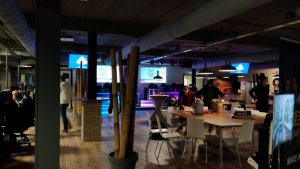
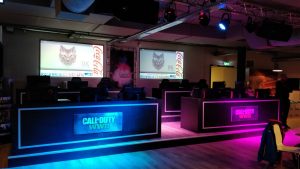
So I have to be honest, the first week we get kinda sidetracked from our actual sprint goal, which is about thinking of what we exactly want to know from the audience and how we are going to ask those questions. We make a questionnaire, but turns out the questions are still a bit generic and feel a bit iffy. We do more research on festival/event experiences with Harry van Vliet, but fail to visualize those findings into concrete prototypes.
On Friday we have a presentation from Emily Hinks on Frame insights & Ideation. Emily gives us a few interesting ways to carry out the questions for our end users. For example, we have to make three big questions that require more than a yes or no answer. Emily also encourages us to ask as much ‘why’ questions as possible. The workshop gives us the fresh breeze we needed and enables us to work more focused the next week.
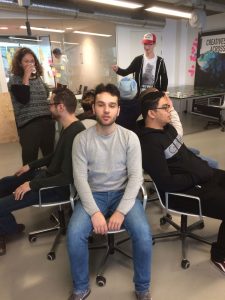
This was a fun energizer that required you to draw the person before you in a short amount of time – and a lot of switching during the drawing! Looking good Burak
Week 2
Wouter gives a workshop on Tuesday on the Data Driven business model. He explains about the Business Model Canvas by Alexander Osterwalder, that might help us with our user research and how it relates to the Data Driven model. He discusses the customer pains and gains. What we want to do in such a business model is take as much pains away as possible and also add gains for the end user in the process.
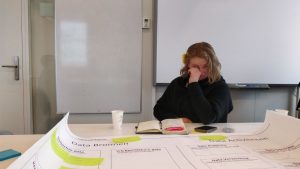
the word ‘categorial’ sounds like ‘Captain Gloryhole’ apparently. Evelien lost it for a moment.
The next day, we attend a presentation by Esther Hammelburg. She explains the concepts around ‘liveness’. All of our stakeholders are there too and during the presentation some of Esther’s liveness findings are linked to the esports environment. Like in the case of the theory of flow, originated from the flow of television programs that manages to make the watchers watch longer. Here, we can combine the pains and gains Wouter was talking about in his workshop with the theory of flow: the pain factors can be seen as obstacles from keeping an event in a natural flow. After the presentation, we agree that we need to work with the question of how exactly we want to steer the flow during the fan experience we want to work on.
We have translate session with Evelien, Wouter and Felipe. They give us feedback on our current questionnaire. We still need to ask more open questions, so we work on that for the day. We use the example questionnaire made for the Rijksmuseum Boerhaave. When we are done with the revisions, we send it to Anne Moes, Evelien’s colleague, for new feedback.
On Friday we meet up with Jeroen from ExMachina. He shows us some of the projects ExMachina is currently working. A lot of them are very inspiring and incorporate some of the liveness concepts that Esther also talked about in an interactive manner. The possibilities of smart click maps seem especially interesting to us.
Week 3

Team Aim’s turn to cook again! This time we made Japanese curry with mashed potatoes.. You can call it a Dutch-Japanese fushion
Anne sends back some useful feedback on our questionnaire so the tinkering continues. Burak keeps developing the questionnaire format.
We decide that we want to refrain from using the Tinder app for asking the users too much complicated questions. Instead, the questions in the app are going to be concept ideas we’ve thought up for audience interaction.
The remaining two days before the sprint review we put all our research, concepts and prototypes together and Rizal makes a presentation out of it.
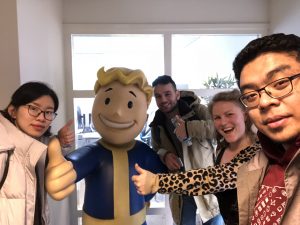
This time we had the sprint review at the eMense office. There was a new guy to take a picture with!
A few concepts were proposed during the sprint review by Aim, but we decided that we are going to focus especially on the offline/online interaction during such an event in such a manner that it will also be valuable to the online audience. Up until now, team Aim has been focusing on the individual interaction during an esport event. They need to keep in mind that they shouldn’t think of interactivity prototypes just for interactivities sake. During the sprint review we also decided that the experience of the event community as a whole will be more valuable to focus on from now on. Aim wants to come in contact with the people with knowledge of chat bottech and/or Paul from ExMachina, as Jeroen mentioned that Paul also has a deep understanding of chatbot technology. Aim is going to look through the possibilities chatbots can bring to us. Throughout the whole conceptualization, Esther Hammelburg’s concepts on liveness will also be used as a reference more frequently. We decided that the concept of a big all-purpose app might be hard to impose on the audience while there are so many chatting apps already. Chatbots from other successful chatting platforms such as Facebook Chat, Wechat, and Twitch will be taken as an inspiration and possible format to work with instead. Finally, Aim needs to add some new questions to our interview that include more questions about chatbot functions. We want to send the final revised interview before Wednesday to everyone. Jeroen and Wouter said they could help us with spreading the interview to their audience. For the next sprint, we want to actually start getting out there with our research and interview people.
The following deliverables were decided on for sprint 3:
1) Analysis of the survey by eMense and ExMachina
2) Another new online/offline interaction concept
3) Work together with Robbert and learn more about the OnLive techniques and concepts
4) Perform user research (actually talk to people)


